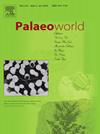中国辽宁下白垩统沙河子地层中的银杏石及其古气候影响
IF 1.7
3区 地球科学
Q2 PALEONTOLOGY
引用次数: 0
摘要
白垩纪大洋缺氧事件(OAEs)期间的极端温室气候是根据海洋地层学认识到的,而由于定量方法的局限性,根据陆地记录对古气候的了解仍然很少。最近活体等值法(如使用气孔指数作为替代物)为重建 OAE 期间的陆地古气候提供了启示。然而,由于缺乏保存完好的具有表皮特征的化石和适用的定量方法,关于Ⅳ属物种的分类和命名仍存在争议,这些物种曾被归入Ⅳ属或Ⅳ属。 在此,我们报告了中国东北辽宁省昌图县下白垩统沙河子地层中保存完好的叶化石。我们估算了化石干叶的单位面积质量(LMA),作为定量的形态和生态替代指标。不同标本的干叶质量(LMA)结果为 192-241 g/m,非常接近,表明这些同名物种应归属于同一物种。因此,结合详细的表皮特征和定量形态学代用指标(LMA),我们将之前描述的化石总结并修正为......。此外,利用...的气孔指数,利用巴克利 SI-CO 曲线计算出中晚期始新世的古大气二氧化碳浓度为 1270 ppmv,表明当时是典型的温室气候,可能与 OAE 全球温度上升事件有关。本文章由计算机程序翻译,如有差异,请以英文原文为准。
Ginkgoites manchurica from the Lower Cretaceous Shahezi Formation of Liaoning, China, and its palaeoclimate implications
The extreme greenhouse climate during the period of oceanic anoxic events (OAEs) in the Cretaceous is recognized based on marine stratigraphy, whereas the palaeoclimate remains poorly understood based on the terrestrial record due to the limitations of quantitative methods. The nearest living equivalent method, such as using the stomatal index of Ginkgo as a proxy, provides insight into reconstructing the terrestrial palaeoclimate during OAEs. However, due to the lack of well-preserved fossils with epidermal features and applicable quantitative methods, there are still controversies regarding the classification and nomenclature of species in the genus Ginkgoites, which have been assigned to Baiera, Ginkgo, or Ginkgoites. Here, we report well-preserved Ginkgoites fossil leaves from the Lower Cretaceous Shahezi Formation in Changtu County, Liaoning Province, Northeast China. The fossil dry leaf mass per area (LMA) was estimated as a quantitative morphological and ecological proxy. The LMA results of 192–241 g/m2 for different specimens are very close, suggesting that these homonyms should be assigned to the same species. Therefore, combining the detailed epidermal features and a quantitative morphological proxy (LMA), we summarized and amended the previously described fossils into Ginkgoites manchurica. Moreover, using the stomatal index of G. manchurica, the palaeo-atmospheric CO2 concentration was calculated at 1270 ppmv using the Barclay SI-pCO2 curve during the middle to late Aptian, indicating a typical greenhouse climate, which may be associated with the OAE global temperature increase event.
求助全文
通过发布文献求助,成功后即可免费获取论文全文。
去求助
来源期刊

Palaeoworld
PALEONTOLOGY-
CiteScore
4.00
自引率
5.90%
发文量
95
期刊介绍:
Palaeoworld is a peer-reviewed quarterly journal dedicated to the study of past life and its environment. We encourage submission of original manuscripts on all aspects of palaeontology and stratigraphy, comparisons of regional and global data in time and space, and results generated by interdisciplinary investigations in related fields. Some issues will be devoted entirely to a special theme whereas others will be composed of contributed articles. Palaeoworld is dedicated to serving a broad spectrum of geoscientists and palaeobiologists as well as serving as a resource for students in fields as diverse as palaeobiology, evolutionary biology, taxonomy and phylogeny, geobiology, historical geology, and palaeoenvironment.
Palaeoworld publishes original articles in the following areas:
•Phylogeny and taxonomic studies of all fossil groups
•Biostratigraphy, chemostratigraphy, chronostratigraphy
•Palaeoecology, palaeoenvironment and global changes throughout Earth history
•Tempo and mode of biological evolution
•Biological events in Earth history (e.g., extinctions, radiations)
•Ecosystem evolution
•Geobiology and molecular palaeobiology
•Palaeontological and stratigraphic methods
•Interdisciplinary studies focusing on fossils and strata
 求助内容:
求助内容: 应助结果提醒方式:
应助结果提醒方式:


